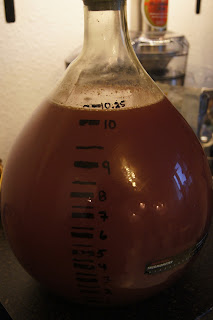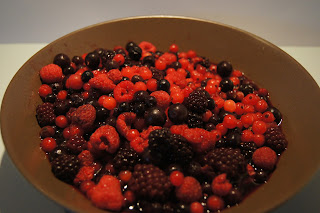Breakfasts here in Germany are rather different then back home. Usually they involve sliced cheeses, deli meats; maybe some smoked salmon or pickled herring and various types of bread. Some scrambled eggs, Nurnberger Sausages or bacon, a hardboiled egg or two. A little bit of Muesli, fresh or dried fruit and yogurt. All in all they are a wonderful experience but lately I’m missing the classic American breakfast. There is something about two eggs done your favourite style with a side of bacon, ham or sausage, some hash browns and maybe a stack of buttermilk pancakes that has the comfort of home to it. Probably my favourite breakfast is a couple eggs over hard with a big side of corned beef hash, add a glass of orange juice and a bottomless cup of coffee and I’m in my own little slice of heaven.
Lunches here are great for the most part and very hearty. Lunch is the major meal of the day, breakfast having lots of options but not necessarily eating all of them and generally dinner is a bit smaller. Lunches are big meals, filling and really get you through the afternoon, but I found recently I’ve been missing that corned beef sandwich or Ruben with extra dressing. A couple nice slices of rye bread, lightly toasted, three or four slices of corned beef, a scoop or so of sauerkraut and some Thousand Island dressing ... Yum!
Are you noticing the theme yet? This week I’m obsessing over Corned Beef. Corned beef ties into the whole concept of Charcuterie and food preservation that I’ve been playing with this year. Basically corned beef is a cured piece of beef that is then boiled until cooked through. I know, I know that description is a little blah, let me try that again. Corned beef is a magnificent piece of beef brisket with all that beautiful fat marbled throughout, which is brined in cure, salt, sugar and various spices to give it a stunning pink colour and an intoxicating aroma and then slowly braised or simmered until that fat melts and the whole brisket falls apart in your mouth. Well doesn’t that sound a little more appetizing?
In general beef is not as cheap here in Germany as it is back home and I haven’t found corned beef on any of the shelves. Papa Thirsty was coming into town for a night and since he’s been living with Mama Thirsty in China for the last year and a half I thought he’d appreciate a little corned beef hash. So I set out, reviewing some recipes online and reading through Michael Ruhlman’s Charcuterie: The Craft of Salting Smoking and Curing and putting together flavours that I like to come up with my own recipe.
Mr. Thirsty’s Corned Beef
So when I was putting this together I was struggling to figure out how to substitute a few things for what I had available her in Germany. I’ll put here both what I used in Germany and what I would use back home in Canada.
Tafelspitz – So this is a cut of beef from the bottom of the sirloin, commonly referred to as the Tri Tip. The Germans have a completely different way of butchering their beef and for the life of me I couldn’t find a brisket to save my life. I was trying to explain what I was doing to the butcher and this little old lady next to me who didn’t speak a lick of English understood and told me that this is what they use for similar recipes.
Markensalz – This is a salt that is produced in Bad Reichenhall, a town in Upper Bavaria near Salzburg, Austria. The don’t really use Kosher salt here that I could find, so I made sure that I did this recipe by weight, eliminating the discrepancy that occurs when referencing salt by volume,
Pökelsalz – This is basically salt with a percentage of nitrites included for food preservation. In North America the amount of nitrite is regulated and the salt is actually dyed pink to ensure that it is not confused for table salt. Here I’ve found it hard to find, finally buying some from my spice guy in the weekly market. Yes I have a spice guy.
Prep Time 60 minutes + 5 days
Cook Time 180 minutes
The Pickling Spice
You can play with these ingredients to suit your tastes, I was surprised when I was done, that the clove actually dominated in the aroma and the bay leaf is really subtle. Remember that the final result really depends on the age of your spices. The spices in that spice rack you got as a wedding present 20 years ago are not going to taste or smell as good as the ones you bought yesterday.
20g Whole Black Peppercorns
20g Whole Yellow Mustard Seeds
20g Whole Coriander Seeds
6g Whole Cloves
2 Cinnamon Sticks, Crushed
10g Dried Juniper Berries
12g Sharp Paprika
14g All Spice, Ground
8g Nutmeg, Freshly Grated
24 Dried Bay Leaves, Crushed
1) Toast the peppercorns, mustard, coriander, cloves, cinnamon and juniper over medium high heat until fragrant
2) Place everything into spice mill and grind to coarse powder
3) Place in a sealable jar
This will make enough picking spice for about 6 – 8 batches of corned beef (est. 120 – 160g).
The Brine
Brining is another way of salt curing. Instead of packing the salt directly onto the flesh, we are dissolving it into water and soaking the meat in the resulting brine. This allows the salt, sugar and flavours to infuse deeper into the meat in a shorter time.
1L Water
225g Markensalz (Kosher Salt)
50g Granulated Brown Sugar (Brown Sugar)
20g Pökelsalz (Curing Salt/Pink Salt)
3 Garlic Cloves, Crushed
10g Pickling Spice
1kg Tafelspitz (Beef Brisket)
1) Add all the ingredients, except the beef, to a pot and bring them to a boil
2) Remove from heat and cover
3) Let the mixture come to room temperature and then chill to the temperature that you will be brining the meat at
4) Rinse the brisket, removing any excess fat and silver skin (the long fibrous tissue that is rather tough to eat) and place into a sealable container that will just fit the brisket and the brine together
5) Pour the chilled brine on top cover and place in the fridge for 5-7 days
The Corned Beef
After all that waiting you basically have a brined cut of beef. What really makes it corned beef now is the way that it’s prepared. Corned beef is boiled or braised to finish. If you were to take the beef, rinse it well at this point and let it rest in the fridge for a day before crusting it with cracked black pepper and coriander and smoking it you would have pastrami, another very yummy dish but today we’re all about the corned beef.
3L Water
10g Pickling Spice
1kg Brined Beef
1) Place the beef into a pot and fill with water until it is just covered
2) Add the pickling spices
3) Bring water to a boil, reduce to a simmer and cover
4) Simmer for about 3 hours, checking occasionally to ensure that the water level hasn’t dropped too much
5) Check the meat with a meat thermometer; it should be about 82°C (180°F). I know this is rather high for beef but the connecting tissue in the beef starts converting to gelatine at that point, making it tender.
6) I have at this point removed the beef from the water and let it rest on a cutting board for about 15 minutes to rest. I usually break of pieces but you could also chill the beef really well and slice it into lunchmeat
Overall I really enjoyed this Corned Beef. When Papa Thirsty was here I made us a Corned Beef Hash that was just awesome and Mrs. Thirsty even told me that this was the first thing I’ve made since she decided to try the veggie lifestyle that she smelled and it made her want to give it all up. She didn’t but maybe I can come up with something for her. Corned Carrots maybe or Corned Celery Root ... Corned Zucchini?? I’ll have to think on it.
Enjoy!














